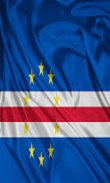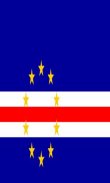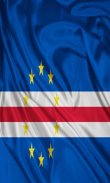







Cape Verde Flag

Descrizione di Cape Verde Flag
The national flag of Cape Verde was adopted on September 22, 1992, replacing the flag adopted during Cape Verdean independence, fought for with Guinea-Bissau, another former Portuguese colony on mainland West Africa.
The 10 stars on the flag represent the main islands of the nation (a chain of islands off the coast of West Africa). The blue represents the ocean and the sky. The band of white and red represents the road toward the construction of the nation, and the colours stand for peace (white) and effort (red). The yellow colour, circular formation of the stars, and dark blue field show similarity to the flag of Europe with 12 stars instead of 10, originally designed for the Council of Europe, but also used by the European Union. The stripes are in 6:1:1:1:3 ratio, and the circle of stars is centred 3/8 along the fly.
Despite its remoteness in elevation with all but 3 islands being mountainous, the lack of natural resources, its isolation from many other countries, and devastating famines in the later 20th century, Cape Verde has won a positive reputation in promoting what is considered the most stable democracy in Africa, a standard of living higher than most African nations, and one of the most politically liberal nations on the continent, and in the world.
Cape Verde (pop. 506,000) is located 500 km from the west coast of Africa. The once uninhabited islands were discovered and colonized by the Portuguese in the 15th century; they subsequently became a trading center for African slaves and later an important coaling and re-supply stop for whaling and transatlantic shipping. Independence was achieved in 1975.
La bandiera nazionale di Capo Verde è stata adottata il 22 settembre 1992, sostituendo la bandiera adottata nel corso di indipendenza del Capo Verde, con combattuto per la Guinea-Bissau, un altro ex colonia portoghese sulla terraferma Africa occidentale.
Le 10 stelle sulla bandiera rappresentano le principali isole della nazione (una catena di isole al largo della costa dell'Africa occidentale). Il blu rappresenta l'oceano e il cielo. La banda di bianco e rosso rappresenta la strada verso la costruzione della nazione, ed i colori stand per la pace (bianco) e lo sforzo (rosso). Il colore giallo, formazione circolare delle stelle, e scuro campo blu mostrano somiglianza con la bandiera dell'Europa con 12 stelle, invece di 10, originariamente progettato per il Consiglio d'Europa, ma utilizzati anche da parte dell'Unione europea. Le strisce sono a 6: 1: 1: 1: 3, e il cerchio di stelle è centrata 3/8 lungo al volo.
Nonostante la sua lontananza in elevazione con tutti ma 3 isole essendo montagnosa, la mancanza di risorse naturali, il suo isolamento da molti altri paesi, e carestie devastanti tardo 20 ° secolo, il Capo Verde ha vinto una reputazione positiva nel promuovere quello che è considerato il più stabile democrazia in Africa, un tenore di vita superiore alla maggior parte delle nazioni africane, e una delle nazioni politicamente più liberale del continente, e in tutto il mondo.
Capo Verde (ab. 506.000) si trova a 500 km dalla costa occidentale dell'Africa. Le isole disabitate una volta sono state scoperte e colonizzate dai portoghesi nel 15 ° secolo; che in seguito divenne un centro commerciale per gli schiavi africani e in seguito un importante rifornimento di carbone e rifornimento stop per la caccia alle balene e la spedizione transatlantica. L'indipendenza è stato raggiunto nel 1975.


























